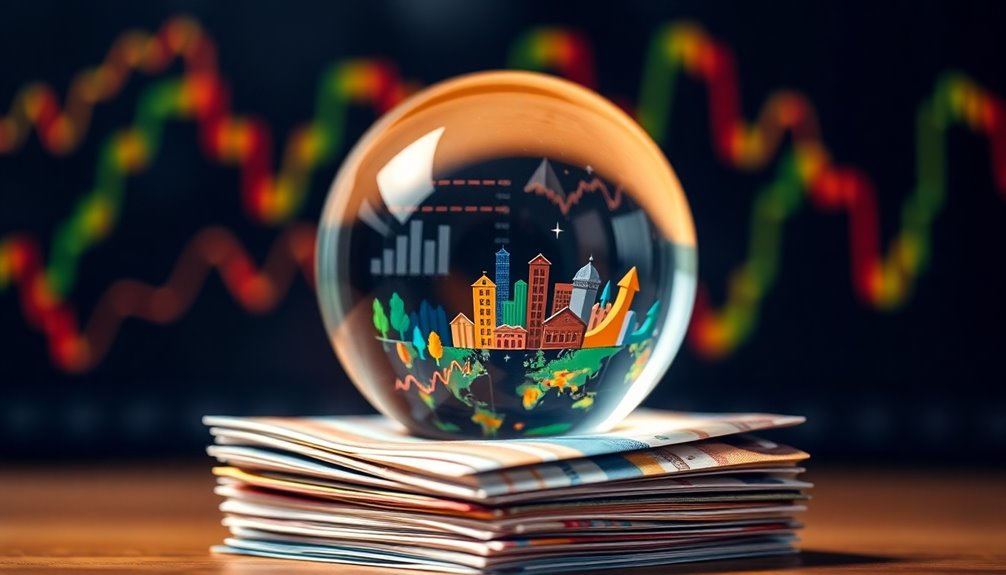Volatility refers to how much prices fluctuate in financial markets, signaling both potential opportunities and inherent risks for you as an investor. When volatility increases, you might see larger price swings, which could lead to significant gains or losses. The Cboe Volatility Index (VIX) is a key measure, often reflecting investor fear or uncertainty. Understanding these fluctuations can help you make better investment decisions. If you're navigating this landscape, grasping the implications of volatility is crucial for your strategy. There's a lot more to uncover about how volatility impacts your investments and risk management.
Key Takeaways
- Volatility refers to the degree of variation in asset prices over time, indicating risk levels in investments.
- High volatility signifies larger price swings, which can present both opportunities and risks for traders.
- The Cboe Volatility Index (VIX) measures market expectations of future volatility, often reflecting investor sentiment.
- Historical volatility (HV) analyzes past price fluctuations, while implied volatility (IV) forecasts future price movements.
- Increased volatility can lead to panic selling and market downturns, creating a feedback loop of instability.
Volatility's Impact on Investments

When it comes to investing, understanding volatility is crucial, as it can dramatically influence your strategies and decisions. Increased volatility often leads to higher risks, pushing you to consider assets with lower volatility to safeguard against potential losses.
The Cboe Volatility Index (VIX) acts as a barometer for market expectations; rising VIX levels typically signal increased investor fear and uncertainty, impacting how you allocate your assets.
Historical volatility (HV) indicates past price fluctuations, and a higher HV might prompt you to exercise caution.
Moreover, grasping the relationship between implied volatility (IV) and options pricing is vital, as higher IV usually results in increased options premiums, which can significantly affect your investment tactics in the derivatives market.
Market Fluctuations Explained

Market fluctuations occur as a natural response to various economic factors and investor sentiments, impacting asset prices and overall market stability.
Volatility is the degree of variation in trading prices, and you can measure it through historical volatility (HV) or implied volatility (IV). Historical volatility looks at past price changes, while implied volatility reflects future expectations derived from option prices.
The CBOE Volatility Index (VIX) serves as a key indicator, predicting market expectations for the next 30 days. When you notice increased volatility, it often correlates with heightened investor fear, resulting in significant price swings.
Understanding these market fluctuations helps you navigate trading strategies and make informed decisions amidst uncertainty.
Price Movement Analysis

Understanding market fluctuations naturally leads to analyzing price movements, which play a critical role in evaluating asset performance.
Volatility measures the extent of these price movements; greater volatility indicates larger swings and heightened risk for you as an investor. Historical volatility (HV) helps you gauge past price fluctuations, showing how much an asset's price deviated from its average.
In contrast, implied volatility (IV) reflects the market's expectations for future price movements, often impacting options premiums. The Chicago Board Options Exchange (CBOE) Volatility Index (VIX) is a vital indicator of near-term volatility, with rising VIX values suggesting increased market uncertainty.
Pros and Cons of Volatility

While volatility can be intimidating, it also presents unique opportunities for savvy investors. The pros of volatility include potential trading opportunities, as increased volatility leads to rapid price movements that can result in significant profits.
Moreover, higher volatility often improves market liquidity, attracting more investors and narrowing bid-ask spreads.
However, the cons of volatility can be substantial. High volatility reflects negative market sentiment, often causing emotional stress for investors, which complicates decision-making.
This anxiety leads many risk-averse investors to shy away from volatile assets in favor of stability.
Ultimately, while volatility can create chances for gains, it also carries risks that you must carefully weigh against your investment strategy.
Volatility vs. Market Stability

When you compare volatility to market stability, it's clear that they represent two distinct approaches to investing.
Volatility showcases rapid price changes, often marked by high volatility, which can create both risks and opportunities. On the other hand, market stability suggests low volatility, with predictable price movements that minimize risk for long-term investors.
The Chicago Board Options Exchange Volatility Index (VIX) acts as a "fear gauge," indicating market expectations of future volatility; higher VIX values signal increased uncertainty. Historical volatility helps you understand past price fluctuations, guiding your investment choices.
While market stability is generally preferred for reducing risk, high volatility can attract traders eager to capitalize on quick price changes, highlighting the balance between risk and reward in investing.
Market Downturns and Investor Panic

Market downturns can trigger intense investor panic, leading to a cycle of fear and rapid price fluctuations. During these times, stock market volatility tends to spike, with the VIX often exceeding 30, reflecting heightened anxiety about future market movements.
Historical prices reveal that significant downturns, like the 2008 financial crisis and the COVID-19 pandemic, resulted in dramatic price volatility, with indices dropping over 30% in mere weeks. Emotional responses, such as panic selling, exacerbate these downturns, creating a feedback loop where increased volatility further destabilizes prices.
This cycle not only prolongs recovery periods but also deepens the overall sense of uncertainty among investors, making it crucial to navigate these turbulent times with a clear strategy.
Recent Market Volatility Patterns

Investor panic during downturns often sets the stage for recent market volatility patterns, where fluctuations continue to respond sharply to external factors.
In 2023, you've likely noticed that the VIX volatility index often rose above 20, signaling heightened investor anxiety. The stock markets have been particularly volatile, with tech stocks like Meta and Amazon swinging over 10% in a single day during earnings season.
Historical data reveals periods of high volatility, especially in early 2023, where the S&P 500 averaged daily moves of over 1.5%.
Additionally, the correlation between oil prices and assets volatility has strengthened, with Brent crude's 30% price increase further contributing to market swings.
Seasonal patterns suggest volatility describes a peak in September and October, aligning with earnings uncertainty.
Diversify Your Investment Portfolio

To navigate the unpredictable nature of the financial landscape, diversifying your investment portfolio is essential. By spreading your investments across different asset classes, like stocks, bonds, and real estate, you can mitigate risks associated with volatility.
Volatility is measured by the fluctuations in asset prices; lower volatility often leads to more stable returns. When higher volatility means greater risk, diversifying your investment portfolio helps balance those risks.
Assets are often considered based on their correlation; combining low-correlation assets can enhance returns while reducing exposure to volatility. Regularly rebalancing your portfolio ensures no single investment disproportionately influences your overall performance, especially during turbulent times.
Historical data shows diversified portfolios tend to outperform non-diversified ones, providing smoother returns even in the broader market downturns. Incorporating assets like gold, which historically retains value during inflationary periods, can further enhance your portfolio's resilience against economic instability.
Frequently Asked Questions
What Is Volatility in Simple Terms?
Volatility's all about how much the price of an asset swings up and down over time.
When you look at a stock, for example, a high volatility means its price can change dramatically, while low volatility indicates it stays relatively stable.
You'll often see volatility measured by standard deviation, which helps you understand the potential risks and rewards.
Is Volatility Good or Bad?
Volatility isn't inherently good or bad; it really depends on your perspective and strategy.
If you thrive on risk and enjoy quick trades, you might see it as an opportunity for profit. However, if you're risk-averse, it could lead to anxiety and loss.
For long-term investors, volatility can be a chance to buy at lower prices.
Ultimately, how you view volatility hinges on your individual risk tolerance and investment goals.
What Does It Mean When Volatility Is High?
When volatility's high, you're looking at significant price swings in the market. This means you might see rapid changes, often exceeding 10%, which can signal increased risk.
You'll notice the VIX rising, indicating market fear and uncertainty. If you're trading options, high implied volatility suggests greater future price movements, leading to higher premiums.
While this environment can offer profit opportunities, you'll need solid risk management to navigate potential losses effectively.
What Does Volatility Mean in Person?
When you think about volatility in personal contexts, it often means your emotions or behaviors can change unexpectedly.
You might find yourself reacting strongly to minor events, leading to sudden mood swings. This unpredictability can create tension in your relationships, as others may struggle to understand your responses.
Conclusion
In conclusion, understanding volatility is crucial for navigating the investment landscape. While it can lead to opportunities, it also brings risks that you need to manage. By recognizing market fluctuations and analyzing price movements, you can make informed decisions. Remember to diversify your portfolio to cushion against downturns and avoid panic. Embracing volatility as part of your strategy can help you thrive in an unpredictable market and ultimately enhance your investment success.









